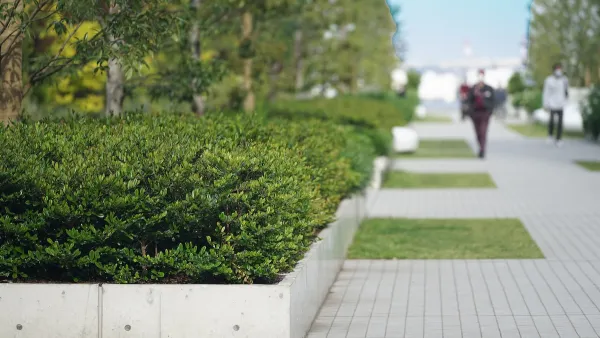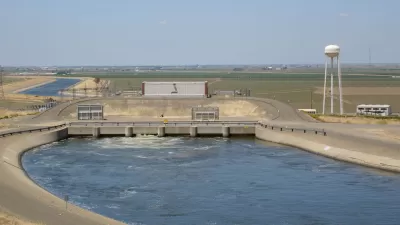Take a kayak trip on the Los Angeles River with KQED science reporter Amy Standen to understand why cities were built on the premise of endless potable water and how we can build cities sustainably in regions that receive low rainfall.
Notwithstand the current desperately needed rains that began falling on Tuesday, California is in the midst of one of one its worst droughts in recorded history. KQED Science editor Kat Snow, in introducing this seven-minute radio program (audio + text), points out that western "cities are to a great extent built on the idea that fresh water is endless." Amy Standen, radio reporter for QUEST, KQED's science and environment show, investigates "where this idea came from and what it would mean to change it."
"To begin this story, I wanted to visit a place that could symbolize the near-complete domination of man over nature; in California — the Los Angeles River stood out," states Standen. "After devastating floods in the 1930s, the Army Corps of Engineers paved it over and channelized it." Now the corps is in the midst of undoing some of their work by recommending approval of a $1 billion plan in May to revitalize an 11-mile stretch of the river."
The river was no longer needed for drinking water thanks to "(a) massive aqueduct (that) pulled in water from the Owens Valley, some 300 miles to the northeast."
"There it is, take it,” city water director and self-taught engineer William Mulholland famously told the residents of Los Angeles when the aqueduct opened in 1913.
But "endless water" can hardly be traced to Mulholland. David Sedlak, a professor of civil and environmental engineering at U.C. Berkeley and author of a new history of water, "Water 4.0," points to a much earlier time and civilization.
“The Romans gave us the idea of public baths, public toilets, fountains and the convenience of water coming directly into your neighborhood,” Sedlak says. “They were able to provide close to 100 gallons per person, per day, which is similar to what we use in some of our modern cities.”
Next stop on the Standen tour is "a single block of Elmer Avenue, in a working-class neighborhood of East Los Angeles called Sun Valley," what she calls 'a prototype for the future city.' "About half of the residents here have replaced their lawns with drought-tolerant landscaping, such as California live oak, rosemary and sage," states Standen, but that's only part of what sets this street apart from others.
"Until a few years ago, Elmer Avenue had a problem with floods," states Standen. "So in 2009, the city embarked on a plan to install new technologies on Elmer Avenue that would transform the way the block used water, including the rain that fell here." According to the Landscape Architecture Foundation:
The Elmer Avenue Neighborhood Retrofit transformed a typical residential street into a model “green street” by incorporating stormwater best management practices (BMPs) that capture and filter runoff from a 40-acre area. Before this project, the Sun Valley neighborhood had no pedestrian or stormwater infrastructure and was subject to frequent flooding. Now vegetated bioswales and a subsurface infiltration gallery that runs the length of the street allow up to 16 acre-feet of water to recharge groundwater supplies annually. These BMPs, along with rainbarrels [sic], trench drains, and permeable pavers on private property, improve the street’s performance and aesthetic qualities, and serve as a demonstration project for both residents and policy makers.
“In an average rain year,” says her tour guide, Hadley Arnold, co-director of the Arid Lands Institute at Woodbury University in Burbank, which trains architects and designers, “this block puts enough water for approximately 30 families for a year into the ground." "In other words," states Standen, "Elmer Avenue is permeable."
If you think about it, this is the opposite of ancient Rome, the opposite of California’s giant aqueducts. Elmer Avenue uses what it gets naturally, rather than relying entirely on imported water.
Arnold points to the peaked roofs of homes on the street and calls them "a useless vestige that has no authentic purpose in this place.”
Most of the homes in this neighborhood have triangular roofs, modeled on homes in colder climates where roofs are designed to shed ice and snow.
Roofs here in Los Angeles’ sunbaked neighborhoods should look different.
“Roofs that are like a wide mouth open to the sky,” Arnold says. “Roofs that are like a cup or a bowl, or an umbrella turned upside down.”
This is arguably the best part of the tape [5:10 mins]. Standen states, "I'm going to stop here for a moment, because what Arnold is getting at is kind of profound; that cities should, wherever possible, be porous. They should be designed to work with the water they have, not fight it," a theme repeated by all of Standen's guests, including Nataly Gattegno, a co-founder of the Future Cities Lab in San Francisco:
"The old ways of building cities and supplying them with water — ideas we borrowed from the ancient Romans — may no longer make sense in California."
"And that's an opportunity," Standen concludes, "to ask not just how we'll survive the drought, but how our cities might be transformed by it; maybe for the better."
FULL STORY: Designing California Cities for a Long-Term Drought

Planetizen Federal Action Tracker
A weekly monitor of how Trump’s orders and actions are impacting planners and planning in America.

Restaurant Patios Were a Pandemic Win — Why Were They so Hard to Keep?
Social distancing requirements and changes in travel patterns prompted cities to pilot new uses for street and sidewalk space. Then it got complicated.

Map: Where Senate Republicans Want to Sell Your Public Lands
For public land advocates, the Senate Republicans’ proposal to sell millions of acres of public land in the West is “the biggest fight of their careers.”

Maui's Vacation Rental Debate Turns Ugly
Verbal attacks, misinformation campaigns and fistfights plague a high-stakes debate to convert thousands of vacation rentals into long-term housing.

San Francisco Suspends Traffic Calming Amidst Record Deaths
Citing “a challenging fiscal landscape,” the city will cease the program on the heels of 42 traffic deaths, including 24 pedestrians.

California Homeless Arrests, Citations Spike After Ruling
An investigation reveals that anti-homeless actions increased up to 500% after Grants Pass v. Johnson — even in cities claiming no policy change.
Urban Design for Planners 1: Software Tools
This six-course series explores essential urban design concepts using open source software and equips planners with the tools they need to participate fully in the urban design process.
Planning for Universal Design
Learn the tools for implementing Universal Design in planning regulations.
Heyer Gruel & Associates PA
JM Goldson LLC
Custer County Colorado
City of Camden Redevelopment Agency
City of Astoria
Transportation Research & Education Center (TREC) at Portland State University
Camden Redevelopment Agency
City of Claremont
Municipality of Princeton (NJ)





























